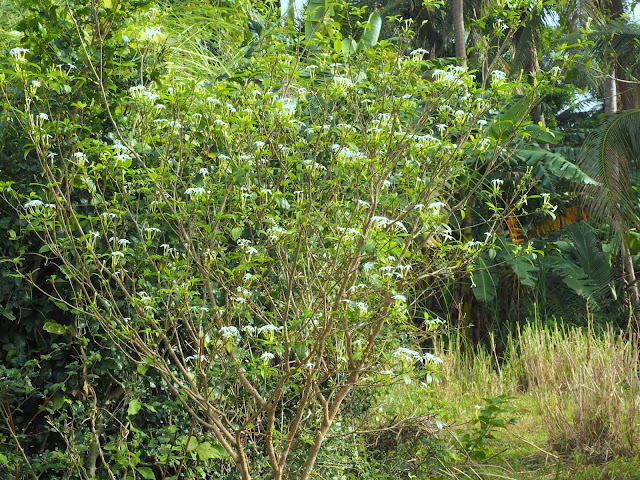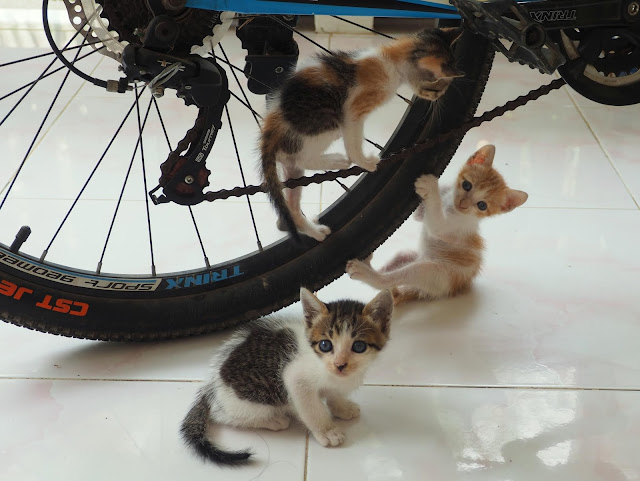Our Rainy Season started in June this year. So our plants this July are already very happy, everything sprouting from rain saturation. I went home some weekends specifically to catch the blooms and to post them here for GBBD. More plants start to show their growth, blooming happily with their plenty of food uptake. And the photographer, in return, is happily documenting their conditions as well. These are just some of the more obviously conspicuous blooms resulting from the heavy rains.
the sleeping shoots were shaken from slumber and produced blooms.
The lilies were terminated off their dormancy, like this
Scadoxus multiflorus or Blood Lily. We don't see them during the dry season, as their leaves are gone with only their live bulbs in the soil. With the first heavy rains they regain growth, all the flowers sprout first before the leaves. They sprouted a bit staggeredly, so we can see the red umbels for at least 2 weeks.
I also observed that the stingless bees swarm on them with their legs full of pollen to be brought to their hives. In a month the umbels will die and be replaced with green leaves, again accumulating food to prepare for their next dormancy in the dry season.
Crinum jagus
Crinum zeylanicum
Pteroceras ungiculatum (orchid)
This is an endemic orchid in the country. It has been there hanging on the trunks of my trees, self-supporting, a bit dying during the dry season but suddenly comes to life with blooms when the rains come. It also produces a lot of pods.
Mussaenda Dona Luz
Those colorful parts are bracts, enclosing the small yellow flowers. We cut all those branches 2x a year when those bracts wither. The succeeding shoots will enable the tree to accumulate food again for the next flowering, which coincides just after the first heavy rains.

Clausena sp. |
This small tree belongs to the Rutaceae which include the citrus. Flowers entice a lot of butterflies there on top. It is called "malarayap" in the our local term because the leaves emit a scent like that of "dayap" or our local lime.
|
Tabernaemontana pandacaqui (pandakaki)
This is a bush which luxuriantly grows in our areas, fallowed lands, under coconut trees, vacant or marginal lands, everywhere in our vicinity. The butterflies also love nectaring on them. It produces very colorful orange pods when ripe that can be easily seen from a distant, in contrast with the green environment.
Hoya lacunosa
Hoya lacunosa is one of the small-leaves hoya, with equally small umbels. But its overpowering scent makes up for the size of the flowers. After the heavy rains it produced a lot of umbels. The above plant alone has 15 umbels.
Hoya lacunosa
Hoya obscura
This plant is also considered small because of the leaves, but it is a bit bigger than H. lacunosa. Even just the lacunosa or the obscura flowers alone are open, one can immediately realize that a hoya is in bloom in the hoya enclosure. The scent is easily discernible at 5 meter radius or 10 m diameter.
Pseudorhipsalis ramulosa (syn. Disocactus ramulosus)
This is a red-leafed hanging cactus whose fruits are so small at less than a centimeter in diameter, changing color from green to white as they mature. Every notch on the leaves produce flowers that eventually become fruits.
Even the fungi are happy emerging with the start of the rainy season as the brown fungus above and the yellow ones below. I do not know their identification.
It is my first time to upload a video in my posts here, but i cannot control sharing with you the happiness of those bees nectaring on the newly opening Hoya alwitriana. This hoya is so much different than most because it opens in the morning, when the bees and other insects are starting to forage for nectar and pollen. Most hoyas open late in the afternoon to early evening. This scene above always happen when an umbel opens but the bees leave after a few minutes.
It is so nice to watch something like this in nature, and the bees do not seem to mind a human watching them. Those honey bees are also endemic in the country, Apis cerana. Their honey is my most prefered honey among the honey producing bees.



































